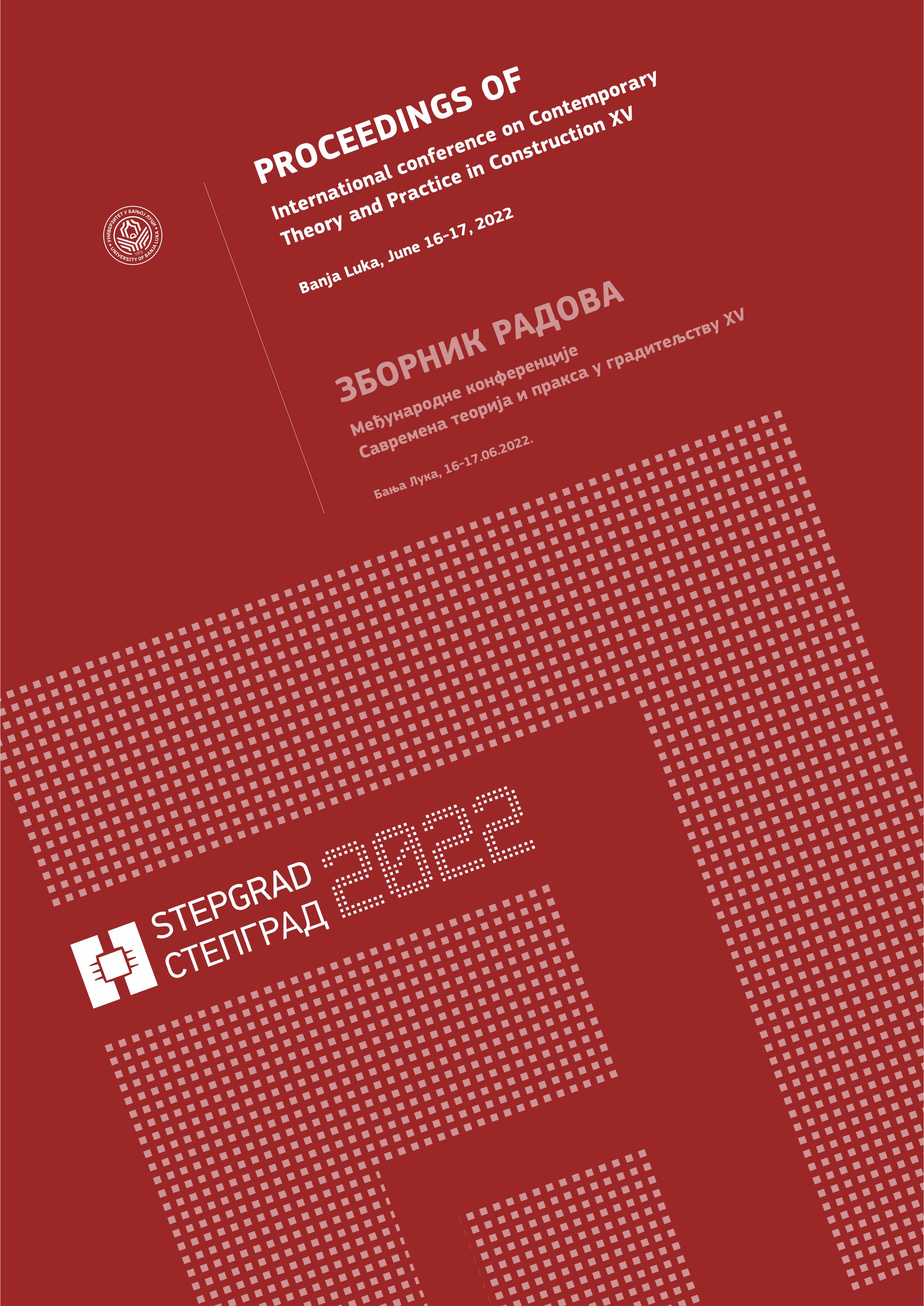EXPERIMENTAL INVESTIGATION OF SCC WITH RECYCLED RUBBER AND RECYCLED CONCRETE AGGREGATE
DOI:
https://doi.org/10.7251/STP2215063PAbstract
The replacement of natural aggregates (NA) with alternative aggregates in concrete can contribute to the sustainable development of the construction industry. This paper aims to present research investigating the effects of recycled concrete aggregate (RCA) and crumb rubber (CR) utilization on the performance of Self-Compacting Concrete (SCC) mixtures in both fresh and hardened states. For this purpose, SCC mixtures with three different replacement levels of CR - 0%, 20% and 30% by volume for fine aggregate and 100% coarse RCA were prepared along with the reference mixture containing NA only. To assess the effects of NA replacement, the physical and mechanical tests were conducted on prepared SCC mixtures and corresponding results were analysed and compared.
References
“Waste statistics.” Internet: https://ec.europa.eu/eurostat/statistics-explained/index.php?title=Waste_statistics, [10.02.2022.].
European Commission, Directorate-General for Internal Market, Industry, Entrepreneurship and SMEs, 3rd Raw Materials Scoreboard : European innovation partnership on raw materials, Publications Office, 2021, Available: https://data.europa.eu/doi/10.2873/680176, [10.02.2022.].
M. Pepe, A Conceptual Model for Designing Recycled Aggregate Concrete for Structural Applications. Springer Theses, 2015.
N. Tošić, A. Savić, and V. Carević, “A method for the continuous measurement of water absorption of coarse recycled aggregates,” in Proceedings of the ASES Symposium 2016, Zlatibor, Serbia, Sep. 2016, pp. 1023-1030.
A. Savić, M. Aškrabić, B. Kovačević, and D. Pavlović, “Properties of SCC Mixtures with Coarse Recycled Aggregate,” in Proceedings of 15th Conference hosted by Association of Structural Engineers of Serbia - ASES, Zlatibor, Serbia, Sep. 2018, pp. 265-274.
M. C. Rao, S. K. Bhattacharyya, and S. V. Barai, Systematic Approach of Characterisation and Behaviour of Recycled Aggregate Concrete. Springer Transactions in Civil and Environmental Engineering, 2019.
V. W. Y. Tam, X. F. Gao, and C. M. Tam, “Microstructural analysis of recycled aggregate concrete produced from two-stage mixing approach,” Cement and Concrete Research, vol. 35, no. 6, pp. 1195–1203, 2005.
J. Xu, Z. Yao, G. Yang, and Q. Han, “Research on crumb rubber concrete: From a multi-scale review,” Construction and Building Materials, vol. 232, pp. 117282-117306, 2020.
S. Raffoul, R. Garcia, K. Pilakoutas, M. Guadagnini, and N. F. Medina, “Optimisation of rubberised concrete with high rubber content: An experimental investigation,” Construction and Building Materials, vol. 124, pp. 391–404, 2016.
Y. Li, S. Zhang, R. Wang, and F. Dang, “Potential use of waste tire rubber as aggregate in cement concrete – A comprehensive review,” Construction and Building Materials, vol. 225, pp. 1183–1201, 2019.
H. Liu, X. Wang, Y. Jiao, and T. Sha, “Experimental Investigation of the Mechanical and Durability Properties of Crumb Rubber Concrete,” Materials, vol. 9, no. 3, 2016.
S. Mindess, “Self-compacting concrete (SCC)” in Developments in the formulation and reinforcement of concrete, 2nd edition. Woodhead Publishing, Duxford, United Kingdom, 2019.
EN 933-1:2012 - Tests for geometrical properties of aggregates - Part 1: Determination of particle size distribution - Sieving method. CEN, Brussels, 2012.
EFNARC. (2005.). The European Guidelines for Self-Compacting Concrete; Specification, Production and Use. [On-line]. Available: www.efca.info/download/european-guidelines-for-self-compacting-concrete-scc/?wpdmdl=652 [10.02.2022.]
EN 12350-8:2019 - Testing fresh concrete - Part 8: Self-compacting concrete - Slump-flow test. CEN, Brussels, 2019.
EN 12350-9:2010 - Testing fresh concrete - Part 9: Self-compacting concrete - V-funnel test. CEN, Brussels, 2010.
EN 12350-10:2010 - Testing fresh concrete - Part 10: Self-compacting concrete - L box test. CEN, Brussels, 2010.
EN 12390-3:2019 - Testing hardened concrete - Part 3: Compressive strength of test specimens. CEN, Brussels, 2019.
EN 12390-5:2019 - Testing hardened concrete - Part 5: Flexural strength of test specimens. CEN, Brussels, 2019.
EN 12390-13:2021 - Testing hardened concrete - Part 13: Determination of secant modulus of elasticity in compression. CEN, Brussels, 2021.
SRPS U.M1.026:1993 - Concrete - Determination of the dynamic modulus of elasticity and Poisson’s ratio. Institute for standardization of Serbia, Belgrade, Serbia, 1993.
EN 12504-4:2021 - Testing concrete in structures - Part 4: Determination of ultrasonic pulse velocity. CEN, Brussels, 2021.
EN 12390-8:2019 - Testing hardened concrete - Part 8: Depth of penetration of water under pressure. CEN, Brussels, 2019.
EN 12350-6:2019 - Testing fresh concrete - Part 6: Density. CEN, Brussels, 2019.
A. M. Neville, Properties of concrete, 5th ed. Harlow, England: Pearson, 2011.
British Standards Institution, Specification for testing concrete. Part 203. Part 203. British Standards Institution, London, 1986.
V. W. Y. Tam and C. M. Tam, “Assessment of durability of recycled aggregate concrete produced by two-stage mixing approach,” Journal of Materials Science, vol. 42, no. 10, pp. 3592–3602, 2007.
SRPS U.M1.206:2013 - Specification, performance, production and conformity - Rules for the implementation of SRPS EN 206-1. Institute for standardization of Serbia, Belgrade, Serbia, 2013.

